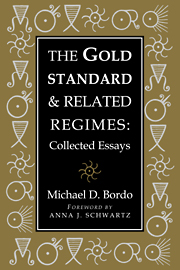Book contents
- Frontmatter
- Contents
- Foreword
- 1 The Gold Standard and Related Regimes: Introduction to the Collection
- Part I History of Doctrine and the Gold Standard
- Part II The Gold Standard as a Commodity Standard
- Part III The Gold Standard as a Contingent Rule
- Part IV Historical Case Studies
- Part V The Bretton Woods International Monetary System
- Index
- Titles in the series
1 - The Gold Standard and Related Regimes: Introduction to the Collection
Published online by Cambridge University Press: 19 October 2009
- Frontmatter
- Contents
- Foreword
- 1 The Gold Standard and Related Regimes: Introduction to the Collection
- Part I History of Doctrine and the Gold Standard
- Part II The Gold Standard as a Commodity Standard
- Part III The Gold Standard as a Contingent Rule
- Part IV Historical Case Studies
- Part V The Bretton Woods International Monetary System
- Index
- Titles in the series
Summary
The gold standard: A subject of perennial interest
The classical gold standard ended in 1914 but it has been the focus of great interest by policymakers and scholars ever since. On four occasions in this century the gold standard rose to the forefront of discussion: after World War I, during World War II, in the mid-1960s, and in the early 1980s.
After World War I, in the face of high inflation and volatile exchange rates, the great powers pushed to return to the gold standard. The Cunliffe Committee report of 1918 urged a return to the prewar standard except that the system would be based upon gold bullion rather than gold coin. The Genoa conference of 1922 recommended restoration of a gold exchange standard as soon as feasible. By 1928 most of the world was part of a gold exchange standard that collapsed several years later during the Great Depression.
During World War II, American planners for the postwar international monetary order attached priority to a gold nominal anchor for the dollar and hence for other currencies pegged to the dollar. Adherence to limited gold convertibility, they believed, would ensure exchange rate stability and thereby encourage the growth of international trade. The resulting Articles of Agreement negotiated at Bretton Woods in 1944, although incorporating the gold parity (at least for the dollar) of the classical gold standard, eschewed many of its other features.
- Type
- Chapter
- Information
- The Gold Standard and Related RegimesCollected Essays, pp. 1 - 24Publisher: Cambridge University PressPrint publication year: 1999



